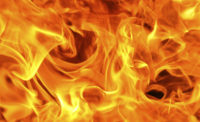Industrial fire safety is a necessary part of any industrial warehouse and manufacturing plant, though fires and explosions vary from causes and severity. As industrial fire protection standards improve each year, safety and health professionals want to ensure the best practices on how to prevent fires and explosions.
Something like combustible dust is a well-known cause of fires and explosions. However, there are several other sources for fires as well. With each cause will come different steps for protection.
1. Hot work
Hot work encompasses tasks like welding, sawing and drilling — anything that involves sparks or is a potential source for ignition. Fires and explosions can start from hot work when the sparks disperse and ignite any flammable items or substances nearby.
For instance, in 2014, a welder's torch ignited several fires that resulted in injuries and fatalities. To prevent hot work fires, professionals should try to opt for any alternative methods when possible. This choice isn't always feasible, so training and clearing the area of flammable things during hot work will help.
2. Electrical
Electrical hazards occur with exposed wiring, overloaded outlets or circuits and extension cords. These instances make for easy ignition. From 2011 to 2015, electrical issues accounted for 24% of structural fires — the highest percentage of all causes. Throughout these years, there were 37,910 fires annually.
Prevention of electrical fires requires proper distribution of power, no overloading of any outlets and keeping extension cord use to a minimum. Electrical components require standard maintenance as well.
3. Machinery
Any machinery that operates frequently or extensively can potentially be a fire and explosion hazard. Due to the friction of moving parts in machines and operations, these items can cause fires. The elements can also jam and cause an explosion.
One example of how to take industrial safety measures is with chillers, which can prevent explosions or fires. These chillers will use a refrigerant to transfer heat away and outside. Cleaning and maintenance will also help reduce machinery fires.
4. Vehicles
Vehicles can run into similar fire and explosion risks as machinery. Some industrial and manufacturing vehicles break down due to poor maintenance or accidents. Overall, vehicle fires contributed to 9% of manufacturing and industrial fires every year from 2011 to 2015.
These statistics still hold true in 2020. Vehicle fires, and industrial fires, in general, are a significant problem within the manufacturing and production sector. Proper maintenance and operation of these vehicles can reduce risks.
5. Gasses and liquids
Some gasses and liquids are inherently flammable. Things like crude oil, rocket fuel and other toxic fluids can easily ignite in a warehouse. Gasses, too, become significantly more dangerous when in contact with a source of fire.
In 2010, a Middletown, Connecticut power plant faced a gas explosion that caused five fatalities. To prevent explosions and fires like these, employees must understand the ideal storage for liquids and how to handle gasses properly. They must always have control over ignition sources as well.
Safety measures to prevent fires and explosions
With each of these areas of risk, proper protection is a top priority. They may all require different forms of protection from eyewear, headwear, gloves and more. Employees will also need the right tools to successfully accomplish each task safely.
Proper training is another important step. Safety increases when employees have a full understanding of their responsibilities and operations. Frequent maintenance will reduce fire and explosion risks, too. Inspections and analyses will help organizations understand what needs updating or replaced.
Procedures and protocols are also invaluable. Professionals should create physical and digital versions of every workers' operations so that they have easy access. Then, with knowledge of protocols in emergencies, employees will know how to work efficiently to contain risks.




